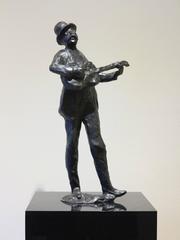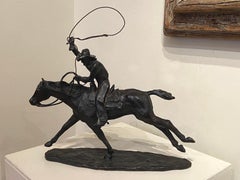Harry Jackson for sale on 1stDibs
Born with the name Harry Shapiro on the South Side of Chicago, Harry Jackson became a well-known 20th-century artists whose wide-ranging work includes painting and sculpture and styles ranging from Abstract Expressionism to Realism.
Jackson was often a truant from school and loved to wander around the Harding Museum looking at Frederic Remington bronzes or to hang out at his mother's cafe listening to stories from the cowboys who had brought their cattle by trains to the stockyards. A teacher noticed his art talent and got him a scholarship to the Chicago Art Institute's Saturday children's classes.
At age 14, he ran away from home to Wyoming where he worked at a lumber company and on a ranch. He regarded these experiences as his spiritual awakening, and his art talents were reinforced by praise from his cowboy peers.
In the late 1930s, he returned to Chicago and studied at the Frederick Mizen Academy, The Chicago Academy of Fine Arts, and The Chicago Art Institute. In 1942, he entered the Marine Corps and became close to a man who introduced him to the classics of literature.
In 1943, at Tarawa, he had shrapnel head wounds that caused him epileptic seizures for most of the remainder of his life, and he also took two bullets to the leg at Saipan. He was then, at age 20, ordered back to the U.S. where he was appointed an Official Marine Corps Combat Artist, the youngest in Marine history.
Following discharge, he worked as a radio actor and went to New York with the idea of meeting his hero, Jackson Pollock. The two formed a lasting friendship, and Pollock introduced Jackson to Abstract Expressionism, which helped Jackson express his troubled background. Jackson married artist Grace Hartigan, his first of six wives, at Pollock's home with Pollock serving as best man. He also took classes at the Brooklyn Museum and studied with Rufino Tamayo and Hans Hofmann.
The newlyweds went to Mexico and further explored abstraction, and a year later the couple divorced. Jackson did scenery painting for theatre and television, headed to Europe, and returned to New York where he did portrait painting and began to break away from Abstract Expressionism, something that met with disapproval from his peers. He had a Fulbright Travel Scholarship, did some heroic paintings in Denmark, and added sculpting to his repertoire, a medium inspired on March 4, 1958 when he arrived in Peitrasanta, Italy, where a new foundry gave him space.
Jackson's work is widely held and includes collections of The Vatican, John Wayne, Queen Elizabeth, and the Smithsonian. He is criticized by some persons for applying paint to his sculpture, but he stays to his own course and asserts: "Don't categorize me . . . as a cowboy or Western artist or abstract expressionist artist. I'm an artist".
Finding the Right figurative-sculptures for You
Figurative sculptures mix reality and imagination, with the most common muse being the human body. Animals are also inspirations for these sculptures, along with forms found in nature.
While figurative sculpture dates back over 35,000 years, the term came into popularity in the 20th century to distinguish it from abstract art. It was aligned with the Expressionist movement in that many of its artists portrayed reality but in a nonnaturalistic and emotional way. In the 1940s, Alberto Giacometti — a Swiss-born artist who was interested in African art, Cubism and Surrealism — created now-iconic representational sculptures of the human figure, and after World War II, figurative sculpture as a movement continued to flourish in Europe.
Lucian Freud and Francis Bacon were some of the leading figurative artists during this period. Artists like Jeff Koons and Maurizio Cattelan propelled the evolution of figurative sculpture into the 21st century.
Figurative sculptures can be whimsical, uncanny and beautiful. Their materials range from stone and wood to metal and delicate ceramics. Even in smaller sizes, the sculptures make bold statements. A bronze sculpture by Salvador Dalí enhances a room; a statuesque bull by Jacques Owczarek depicts strength with its broad chest while its thin legs speak of fragility. Figurative sculptures allow viewers to see what is possible when life is reimagined.
Browse 1stDibs for an extensive collection of figurative sculptures and find the next addition to your collection.

